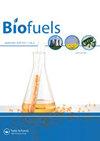通过掺杂提高生物炭性能:蔗渣和鸡毛的比较研究
IF 2.6
4区 工程技术
Q3 ENERGY & FUELS
引用次数: 0
摘要
摘要本研究以甘蔗渣(SB)和鸡毛(CF)为原料,采用掺杂策略制备生物炭。两种生物炭分别为SB92CF-BC (92% SB和8% CF)和CF92SB-BC (92% CF和8% SB),产率分别为34%和27%。傅里叶变换红外光谱(FTIR)分析揭示了两种生物炭的特征官能团,掺杂过程的影响最小。扫描电子能谱(SEM)分析表明,SB92CF-BC表面光滑,CF92SB-BC表面不规则粗糙。能量色散x射线能谱(EDS)分析证实了两种生物炭中存在多种元素,CF92SB-BC中氮含量较高。brunauer - emmet - teller (BET)分析表明,这两种生物炭的比表面积显著高于未改性的SB和CF生物炭。研究结果表明,兴奋剂策略可能产生协同效应。该研究扩展了从不同生物质来源生产生物炭的知识,并强调了利用木质纤维素和非木质纤维素生物质废料生产可持续生物炭的潜力。本文重点研究了以蔗渣和鸡毛为原料生产生物炭的比较研究。在所得生物炭中观察到的独特性质,包括官能团、形态和元素组成。在土壤修复、固碳和废水处理方面具有广泛的潜在应用。关键词:可持续废弃物管理生物炭甘蔗甘蔗渣鸡毛肥料致谢所有在本文中被引用的作者在此致谢。作者:sebuka Chizitere Emenike;方法论、数据整理、写作——原稿;写作-审查和编辑;维克多·特米托普·阿莫萨;写作——原稿;写作-审查和编辑;金斯利·o·乌佐尔;方法论、写作——初稿;写作-审查和编辑;michael;写作——原稿;写作-审查和编辑;凯欣德·特米托普·迈克尔;写作——原稿;写作——审阅和编辑;阿德瓦莱·乔治·阿德尼伊;概念、方法、写作——初稿;写作-审查和编辑;验证;监督披露声明作者未报告潜在的利益冲突。数据可用性声明数据共享不适用于本文,因为本研究没有创建或分析新的数据本文章由计算机程序翻译,如有差异,请以英文原文为准。
Enhancing biochar properties through doping: A comparative study of sugarcane bagasse and chicken feather
AbstractThis comparative study explores the production and characterization of biochar derived from a combination of sugarcane bagasse (SB) and chicken feathers (CF), with a doping strategy for each biomass in the other. Two biochars, SB92CF-BC (92% SB and 8% CF) and CF92SB-BC (92% CF and 8% SB), were produced using a top-lit updraft reactor, resulting in a yield of 34% and 27%, respectively. Fourier transform infrared spectroscopy (FTIR) analysis revealed characteristic functional groups in both biochars, with minimal impact from the doping process. Scanning electron spectroscopy (SEM) analysis showed distinct morphological features, with SB92CF-BC exhibiting a smoother surface and CF92SB-BC displaying an irregular and rough morphology. Energy dispersive X-ray spectroscopy (EDS) analysis confirmed the presence of several elements in both biochars, with a higher nitrogen content in CF92SB-BC. Brunauer-Emmett-Teller (BET) analysis demonstrated significant specific surface areas for both biochars, exceeding those reported for unmodified SB and CF biochars. The findings suggest potential synergistic effects resulting from the doping strategy. The study expands knowledge on biochar production from diverse biomass sources and highlights the potential for utilizing lignocellulosic and non-lignocellulosic biomass waste materials for sustainable biochar production.Article HighlightsComparative study on biochar production from sugarcane bagasse and chicken feathers.Unique properties observed in resulting biochars, including functional groups, morphology, and elemental composition.Versatile potential applications in soil amendment, carbon sequestration, and wastewater treatment.Keywords: Sustainable waste managementbiocharsugarcane bagassechicken feathersdoping AcknowledgementAll authors whose works are cited in this article are hereby acknowledged.Author contributionsEbuka Chizitere Emenike; Methodology, Data curation, Writing - original draft; Writing - review & editing; Victor Temitope Amusa; Writing - original draft; Writing - review & editing; Kingsley O. Iwuozor; Methodology, Writing - original draft; Writing - review & editing; Taiwo Temitayo Micheal; Writing - original draft; Writing - review & editing; Kehinde Temitope Micheal; Writing – original draft; Writing – review and editing; Adewale George Adeniyi; Conceptualization, Methodology, Writing - original draft; Writing - review & editing; Validation; SupervisionDisclosure statementNo potential conflict of interest was reported by the author(s).Data availability statementData sharing is not applicable to this article as no new data were created or analyzed in this study
求助全文
通过发布文献求助,成功后即可免费获取论文全文。
去求助
来源期刊

Biofuels-Uk
Energy-Renewable Energy, Sustainability and the Environment
CiteScore
5.40
自引率
9.50%
发文量
56
期刊介绍:
Current energy systems need a vast transformation to meet the key demands of the 21st century: reduced environmental impact, economic viability and efficiency. An essential part of this energy revolution is bioenergy.
The movement towards widespread implementation of first generation biofuels is still in its infancy, requiring continued evaluation and improvement to be fully realised. Problems with current bioenergy strategies, for example competition over land use for food crops, do not yet have satisfactory solutions. The second generation of biofuels, based around cellulosic ethanol, are now in development and are opening up new possibilities for future energy generation. Recent advances in genetics have pioneered research into designer fuels and sources such as algae have been revealed as untapped bioenergy resources.
As global energy requirements change and grow, it is crucial that all aspects of the bioenergy production process are streamlined and improved, from the design of more efficient biorefineries to research into biohydrogen as an energy carrier. Current energy infrastructures need to be adapted and changed to fulfil the promises of biomass for power generation.
Biofuels provides a forum for all stakeholders in the bioenergy sector, featuring review articles, original research, commentaries, news, research and development spotlights, interviews with key opinion leaders and much more, with a view to establishing an international community of bioenergy communication.
As biofuel research continues at an unprecedented rate, the development of new feedstocks and improvements in bioenergy production processes provide the key to the transformation of biomass into a global energy resource. With the twin threats of climate change and depleted fossil fuel reserves looming, it is vitally important that research communities are mobilized to fully realize the potential of bioenergy.
 求助内容:
求助内容: 应助结果提醒方式:
应助结果提醒方式:


